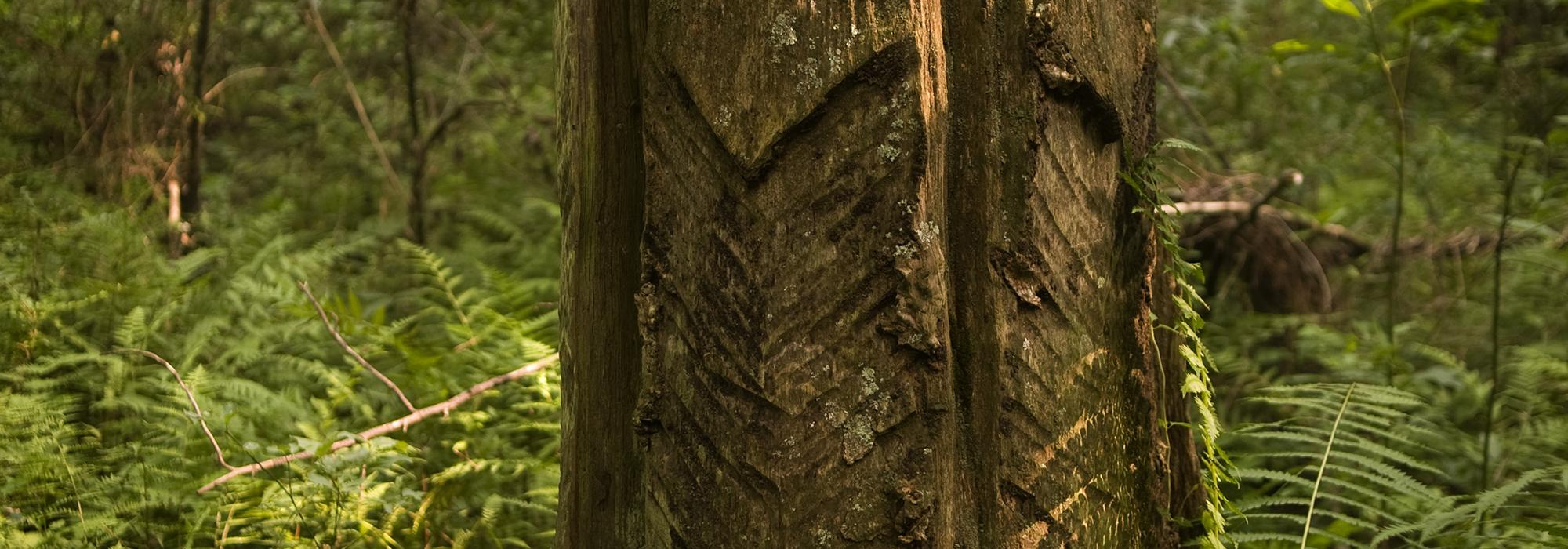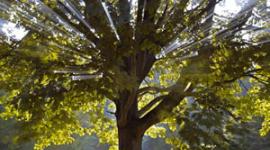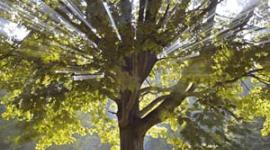Landslide: Every Tree Tells a Story Photography Exhibition Opens at 21C Museum in Louisville, KY Sept. 16 – Concurrent Outdoor Signboard Exhibition at Yew Dell Botanical Gardens in Crestwood, KY Opens Sept. 11
Media Contact: Nord Wennerstrom, Wennerstrom Communications | T: 202.255.7076 | E: nord@wennerco.com
Exhibitions Highlight Unique, Unusual and Irreplaceable Trees and Tree Groupings
2010 Landslide: Every Tree Tells a Story Done in Partnership with The Davey Tree Expert Company
Washington, DC (September 7, 2011) – The Cultural Landscape Foundation’s (TCLF) 2010 Landslide: Every Tree
Tells a Story traveling photography exhibition featuring 26 images of 12 different locations in the US and
Puerto Rico, opens September 16, 2011 at 21c Museum, Louisville, KY, and runs through January 8, 2012.
Concurrently, an outdoor signboard exhibition based on the Landslide photography will open September 11,
2011 at Yew Dell Gardens, Crestwood, KY, and runs through December 31, 2011. Landslide, first issued in 2003,
is TCLF’s annual compendium of significant at‐risk parks, gardens, horticultural features, and working
landscapes and each year is accompanied by a traveling exhibition of commissioned photography. The 2010
Landslide: Every Tree Tells a Story focuses on the irreplaceable trees and tree groupings, often associated
with historically important people and events that have shaped the development of communities and
cultures. Russell Hart, former executive editor at American Photo magazine, commissioned the photography.
The Davey Tree Expert Company is Presenting Sponsor.
The traveling photography exhibition features sentinel and specimen trees, allées and boulevards, urban
forests, formal and vernacular— things that surround us and are living reminders of our heritage. These
trees and tree groupings recall our nation’s past and have the potential to bear witness to coming
generations. These natural and living features command the same awe and admiration that our culture
bestows upon the arts, architecture and design. The 2010 Landslide: Every Tree Tells a Story sites are
(alphabetical by location):
Aoyama Tree ‐ Los Angeles, CA
The 60 by 70‐foot Moreton Bay Fig tree (Ficus macrophylla) marks the former location of the Koyasan Daishi
Mission, one of the city’s oldest and largest Buddhist temples. The tree, nearly 100 years old, stands as a
living symbol of the city’s cultural and historical development of Buddhism and the Japanese American
community. Photography by Robert Glenn Ketchum.
Arborland Tree Farm ‐ Milliken, CO
This orderly forest inhabited by diverse wildlife is actually a 150‐acre tree farm filled with a mixture of shade
and ornamental trees and conifers. The farm’s dense canopy is an anomaly in this plains area along the South
Platte River. Photography by Jay Dickman.
Tulip Poplar ‐ Tudor Place, Washington, DC
Tudor Place, built in 1805, has a beautiful collection of specimen trees on its 5‐½ acre property but there is
one in particular that shines brighter than the rest. A tulip poplar (Liriodendron tulipifera), which stands
more than 80‐feet tall with a diameter of 60 inches, has been present since the founding of Washington, DC
as a small port city in the 18th century. Each passing year brings another chance for danger whether it is from
shifting weather patterns, changes in urban development, or from environmental effects. Photography by
Amy Bedik.
Cummer Oak ‐ Cummer Museum of Art, Jacksonville, FL
In the 1890s, when the Cummer family settled on the banks of the St. Johns River, this Live Oak tree (Quercus
virginiana) was already majestic. Since that time, it has grown to 80‐feet tall with a 138‐foot span and has
witnessed the garden’s evolution from O.C. Simonds’ picturesque 1903 gardens to the formal English and
Italian gardens designed by Thomas Meehan & Sons, Ellen Shipman, and the gardens’ owner, Ninah Cummer.
Photography by Larry Nighswander.
Sycamore Row ‐ Ames, IA
Professor of Horticulture A.T. Erwin planted this linear feature of almost 50 Sycamore trees (Platanus
occidentalis) in the early 1900s parallel to the Ames‐to‐Campus railway at Iowa State University. While the
tracks for the old steam engine and electric trolley have since disappeared, the trees continue to mark the
historic transportation route used by countless Midwestern pioneers. Photography by David Jordano.
Olmsted Parks and Parkways ‐ Louisville, KY
This system consists of three flagship parks (Cherokee, Shawnee, and Iroquois) and the six parkways that
connect them, all designed by Frederick Law Olmsted, Sr. and his sons. For more than three decades, the
Olmsted firm shaped the city—18 parks and 14.5 miles of boulevards in all—each designed in deference to
natural topographic attributes. Today some 6,000 trees from the Olmsted design era provide the city its
mature tree canopy. Photography by Bob Hower.
Commonwealth Avenue Mall ‐ Boston, MA
Initially laid out in Arthur Gilman’s 1850s plan for the Back Bay neighborhood, the original nine‐block mall was
begun in 1876 and completed in 1881 (with additional sections designed over subsequent decades). The
original portion links the Boston Common and Public Garden to Boston’s famed Emerald Necklace and
stands as a premiere example of a tree‐lined avenue. Photography by James Sheldon.
Boxed Pines ‐ Weymouth Heights, Southern Pines, NC
Hundreds of Longleaf Pine trees (Pinus palustris), scattered throughout the subdivision, are marked with
carvings, known as boxes, made by former slaves and their descendants to collect sap for turpentine, pitch,
and rosin. In 1904, industrialist James Boyd purchased the land and landscape architect Alfred Yeomans
incorporated the old‐growth trees into his design for the Weymouth Heights subdivision. Photography by
Frank Hunter.
Japanese Flowering Cherry Trees – Essex County Branch Brook Park, Newark, NJ
Conceived by Frederick Law Olmsted, Sr. in 1867, the 360‐acre park was later redesigned by the Olmsted
Brothers firm. The collection of Japanese Flowering Cherry trees (Prunus), established in 1928, numbers
more than 4,000 today and rivals the more famous collection in Washington, DC’s Potomac Basin both in
actual number and varieties. Photography by Yong Hee Kim.
Elms Of East Hampton ‐ East Hampton, NY
Founded in 1648, the village of East Hampton displays one of the nation’s finest small architectural and
landscape ensembles. By 1895, its American Elm trees (Ulmus americana) were noted in print and, in 1920,
were made famous by a Childe Hassam painting of the village. While disease and insects have threatened the trees, nearly 150 of the specimens continue to form a high, leafy canopy over the village streets. Photography by Garie Waltzer.
Black Oak Tree ‐ Katewood, Bratenahl, OH
Katewood, historically owned by the Holden family, today best known as the founders of the Holden
Arboretum, is a Country Place era estate designed by A.D. Taylor. The Black Oak tree (Quercus velutina) that
pre‐dates the house stands as a rare remnant of the area’s pre‐settlement era. Photography by Barbara
Bosworth.
Río Piedras Ficuses ‐ San Juan, PR
Three African Cloth‐Bark trees (Ficus nekbuda) located along one of Puerto Rico’s busiest thoroughfares are
approximately 50‐feet tall, with a 20‐foot total trunk diameter. Reminiscent of the farmsteads that once
inhabited the region, their combined canopy stretches over seven lanes of highway and marks the entry
point to Río Piedras and the greater and San Juan metropolitan area. Photography by Juan Pons.
“Each year’s ‘Landslide’ highlights different aspects of our landscape legacy, with the collective goal of
making our landscape heritage visible,” said Charles A. Birnbaum, TCLF founder and President.
"These aren't just pretty pictures of old trees," says Russell Hart, former executive editor at American Photo
magazine. "They are important photographers' studies of unique specimens in context, from parklands to
roadsides. Each of the 12 trees or groups of trees is seen through the lens of an artist's sensibility, in
spectacular prints—and the images are as different as they could be."
“21c Museum’s mission is to bring contemporary art to the public in new ways and our belief that
contemporary art provokes important dialogue. We are pleased to partner with The Cultural Landscape
Foundation (TCLF) to tell the story of twelve at risk cultural landscapes in the United States. This exhibition
illustrates how landscapes like Louisville's Olmsted Park system have become narratives of our culture and
expressions of our regional identity,” said Museum Director William Morrow.
“These signboards illustrate how landscapes like Louisville's Olmsted Park system have become narratives of
our culture and expressions of our regional identity,” says Paul Cappiello, Executive Director of Yew Dell
Botanical Gardens. “Exhibiting the boards in Yew Dell’s arboretum is our way of strengthening the
connection between that heritage and current residents of the community.”
About 21c Museum
21c Museum (www.21cmuseum.org) is North America’s first museum dedicated solely to collecting and exhibiting art of the 21st
century. The 9,000‐square‐foot Museum is part of the 21c Museum Hotel, located in downtown Louisville’s
art and theater district. 21c was opened in 2006, and was founded by Laura Lee Brown and Steve Wilson,
philanthropists and arts patrons who are committed to bringing works of art to the public through
innovative exhibitions and programs that integrate contemporary art into daily life. The exhibitions and
installations of 21c Museum weave into the fabric of the hotel and the surrounding streetscape, with works
of art filtering into both public space and unexpected places. There is no hierarchical demarcation between
the areas of the Museum and the other public spaces of 21c. Works of art appear in elevators, public
restrooms, sunken courtyards, hallways, guest rooms, the walls and corners of the Proof on Main restaurant
and bar, and on the floor, windowpanes, roof, and the city sidewalk. 21c Museum is open free of charge 24
hours a day, seven days a week.
About Yew Dell Botanical Gardens
Yew Dell Botanical Gardens (www.yewdellgardens.org), located just 15 minutes from downtown Louisville, KY, is a public botanical garden
dedicated to garden display, research, education and community events – all offered in a regionally significant
historic site. The gardens occupy the former home, farm and commercial nursery of Theodore Klein and his family. Klein was a leader in the regional nursery industry in the second half of the 20th century and was known
internationally as a collector and introducer of superior garden plants. Yew Dell Botanical Gardens offers programs
for gardeners of all levels from school children and families to casual gardeners, advanced plant collectors and green industry professionals. Classes range from hands on gardening workshops to science‐based lectures, garden travel talks, garden cooking classes and more. The annual community event calendar includes a garden sculpture show, spring plant sale, hummingbird festival and both domestic and international garden tours to name a few. Yew Dell’s grounds are adorned with exquisite plant collections, extensive and varied gardens and a collection of unique historic buildings. Yew Dell was recently listed on the National Register of Historic Places.
About The Davey Tree Expert Company
The Davey Tree Expert Company (www.davey.com) has been offering horticultural services in North America
since 1880. Currently, Davey operates throughout North America, providing tree, shrub and lawn care, utility
services, landscape management and consulting services.
Since 1979, Davey has been owned by its employees who take seriously their responsibility to provide
horticultural expertise, industry leadership and to serve as responsible stewards of the environment. Davey’s
support of The Cultural Landscape Foundation and American Forests demonstrates their dedication to the
preservation of trees and the environment for future generations so they can enjoy the aesthetic and social
benefits a healthy landscape provides.
About The Cultural Landscape Foundation
The Cultural Landscape Foundation (www.tclf.org) provides people with the ability to see, understand, and value
landscape architecture and its practitioners, in the way many people have learned to do with buildings and their
designers. Through its Web site, lectures, outreach, and publishing, TCLF broadens the support and understanding
for cultural landscapes nationwide to help safeguard our priceless landscape heritage for future generations.






